| Nikon D4, Sigma 120-300mm f/2.8 DG OS HSM, Sigma 2x EX DG APO Autofocus Teleconverter, ISO 1100, ƒ/5.6, 1/2000 |
If Ansel Adams had shot football games like many photographers, he would have never become famous.
Ansel Adams is not a great photographer because he was able to capture a great moment and compose it compellingly. However, he is a great photographer because he went beyond just the capture and spent months trying to process and print images just right.
Today’s cameras help you capture the zone system with little skill required by the photographer. But unfortunately, this technology can be a problem today. Too many photographers shoot football games, for example, and crop the photograph and then publish the photo.
 |
| The same photo as above, but this is with no post-processing other than a slight crop. |
Post Processing is Key
You can see the difference between the photo above that I took into Adobe Lightroom and worked on to give me the results above versus the same Nikon RAW NEF file exported from PhotoMechanic to a JPEG after a slight crop.
Here is another example for you to see the comparison.
 |
| Nikon D4, Sigma 120-300mm f/2.8 DG OS HSM, Sigma 2x EX DG APO Autofocus Teleconverter, ISO 500, ƒ/5.6, 1/2000 |
 |
| No processing other than slight crop |
Comparing the Histogram on the top photo
 |
| Before |
 |
| After |
You are not trying to get a perfect bell curve histogram. You are trying to be sure that in the top Histogram, you can see a lot of information on the far right. On the far right of the Histogram are the highlighted details. You are recovering this by sliding your highlights to the left to retrieve that information.
These are just the adjustments I made for the top photo. In the middle of the daylight, faces in helmets go black and white shirts lose details. I am trying to open up the shadows and recover the highlights.
Here you can see the area I then dodged in the photo to be sure you could see the player’s face. Here are the actual slider settings for the dodge here:
RAW vs. JPEG
I understand that shooting RAW takes more space and more time to process than just shooting a JPEG and using that image. However, I hope I have established this is not the way to make your work stand out.
With the RAW image, you have all the information that landed on the CMOS chip of the Nikon D4. I have a more dynamic range in the picture than can be seen by my computer monitor.
With a JPEG, the camera’s computer makes some assumptions and then tosses out some of that information to save space for your image file size.
If you shoot JPEGs for daytime football, that will become difficult for you to correct later in post-processing.
First, if your white balance is not just perfect and you want to correct it later, the nuances of color shifting this to what is possible is no longer there. So you have tossed out some of that information.
Second, all the information in those blown-out highlights is no longer there. So, for example, your ability to add folds back into those white jerseys will not be possible.
Third, the amount of information in those shadows is also lost. The camera software assumed you wanted black areas, so you have less information to open up those shadows.
 |
| Nikon D4, Sigma 120-300mm f/2.8 DG OS HSM, Sigma 2x EX DG APO Autofocus Teleconverter, ISO 900, ƒ/5.6, 1/2000 |
Which photo do you prefer? Is this one just above or the one just below?
When it comes to evaluating the two photos, there is one thing that I look for in sports photos that is hard to see in the second unprocessed image—expression. I believe your sports photos are better when you can show the faces of the athletes; you help communicate the effort and competition of the peak action.
Notice the highlights blowing out in the lower photo and how many of the shadows are too dark.
Post-processing matters with your photos. Do more than crop your pictures and add captions; you will stand out from the pack.





